Winners of the 2025 Hobin Prize in Architecture & City Building
January 28, 2025
Six teams of undergraduate students have received awards in the 2025 Hobin Prize in Architecture & City Building for projects exploring adaptive reuse and high-density urban housing on sites in Ottawa.
The student projects were divided among three sites:
- Foster Farm
- Greenboro LRT Park & Ride
- 1245 Kilborn Place
Three teams, working in pairs, won a top prize of $1,000 each. They are Jack Dawson and Daniel Ganesh, Will Girard and Marandy Gonzalez, and Darion Dillabaugh and Lauren Newell.
In addition, three projects received an honourable mention award of $500 each. The two-person teams were Klariza Mae Juntilla and Sharmeen Rizvi, Helen Wang and Yiping Zhan, and Megan Elekes and Kayla Wallace.
“The prize is not only a great opportunity to acknowledge really good work, but it’s also a great opportunity to put your work up on the walls and let the school see it,” said Associate Professor Benjamin Gianni, who coordinated the studio. “Be proud of what you’re displaying to the school.”
See the projects below.
–
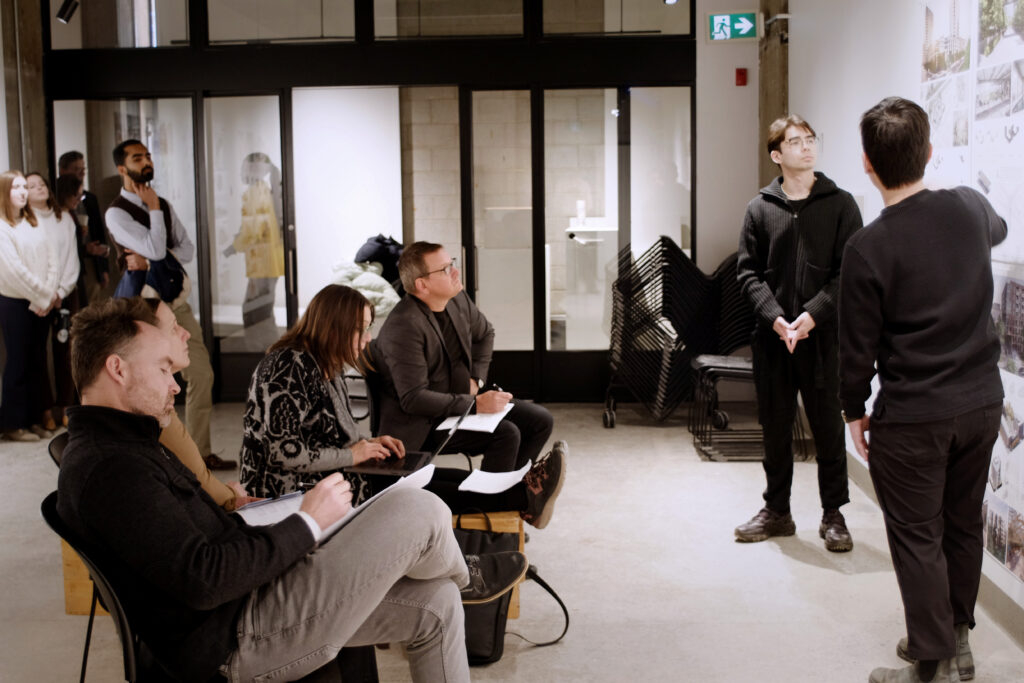
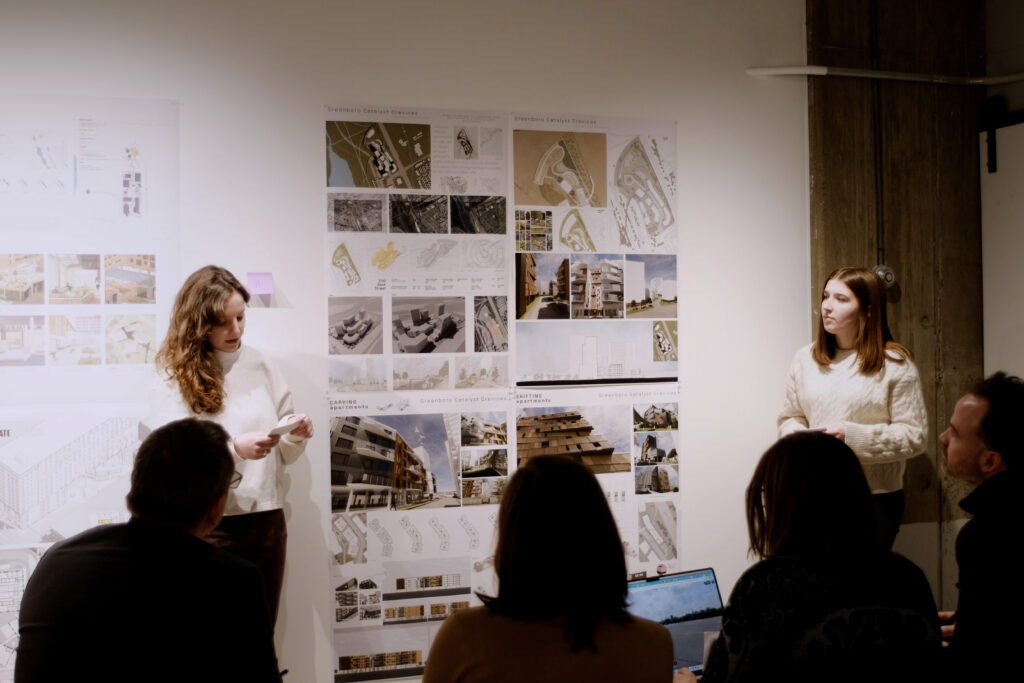
Hobin Architecture, an Ottawa firm that devotes much of its energy to urban residential buildings, established the annual prize in 2019 to recognize outstanding work in the fourth-year housing studio at the Azrieli School of Architecture & Urbanism.
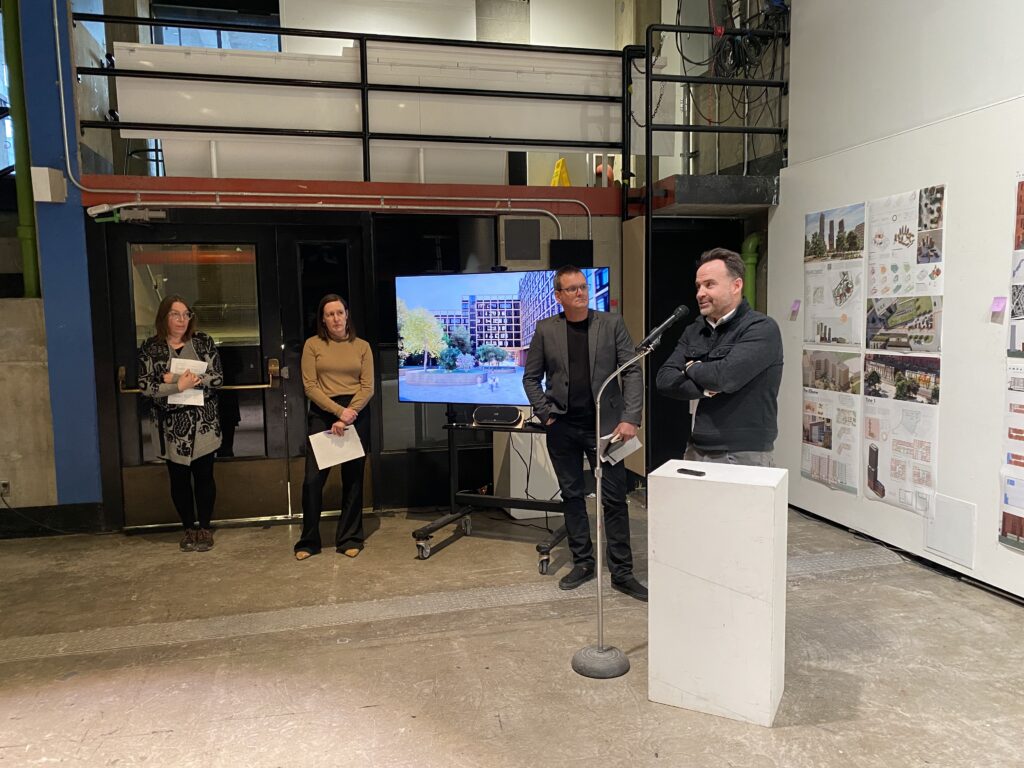
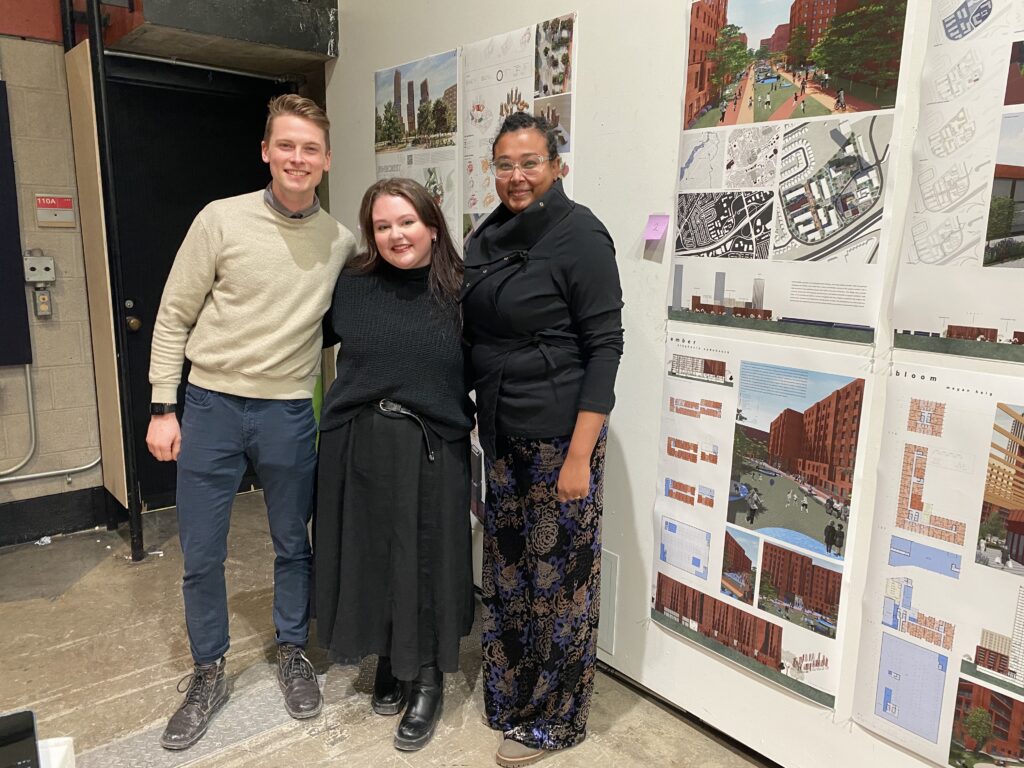
The awards ceremony took place on January 24 at the Architecture Building.
The students presented their projects to the four-member jury, which included three members of Hobin Architecture: Rhéal Labelle, Marc Thiverge, and Melanie Lamontaigne. Associate Professor Janine Debanné was also on the jury. All are alumni of the school.
The jury considered 17 projects nominated by the six professors and instructors who taught the studio in the fall of 2024: Associate Professor Benjamin Gianni (Coordinator), Assistant Professor Menna Agha, Adjunct Professor John Cook, Adjunct Professor Honorata Pienkowska, Instructor Karen Lindkvist, and Instructor Benoit Maranda.
“This is not an easy task,” said Labelle. “You’re having to deal with a lot of density, a lot of people, and you’ve got to create quality spaces around these buildings that will attract and create vibrant, human-scale residential habitats for years to come. It’s very challenging.”
–
Top Prize: $1,000
Kilborn Crossings (Kilborn Place)
Jack Dawson and Daniel Ganesh
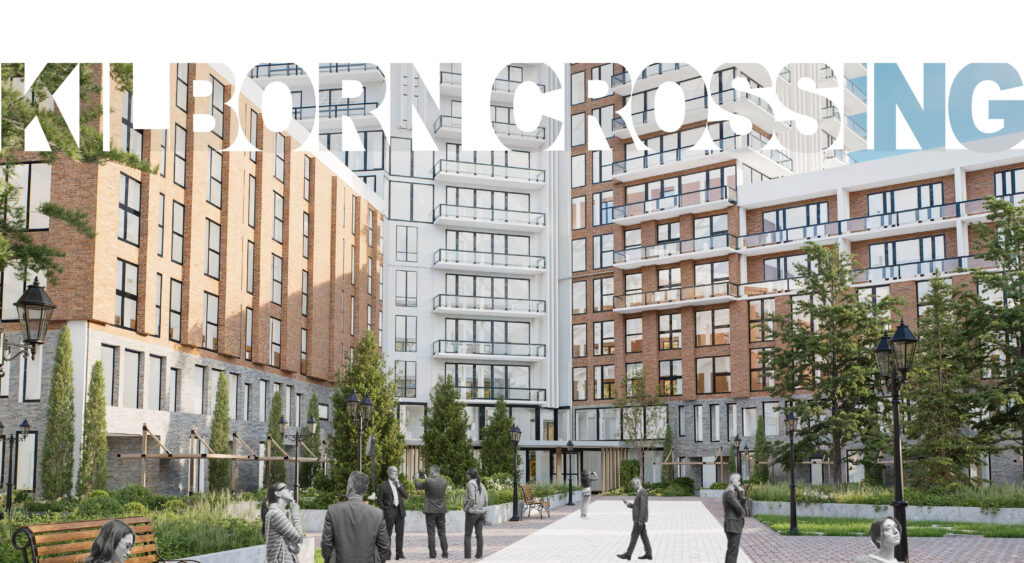
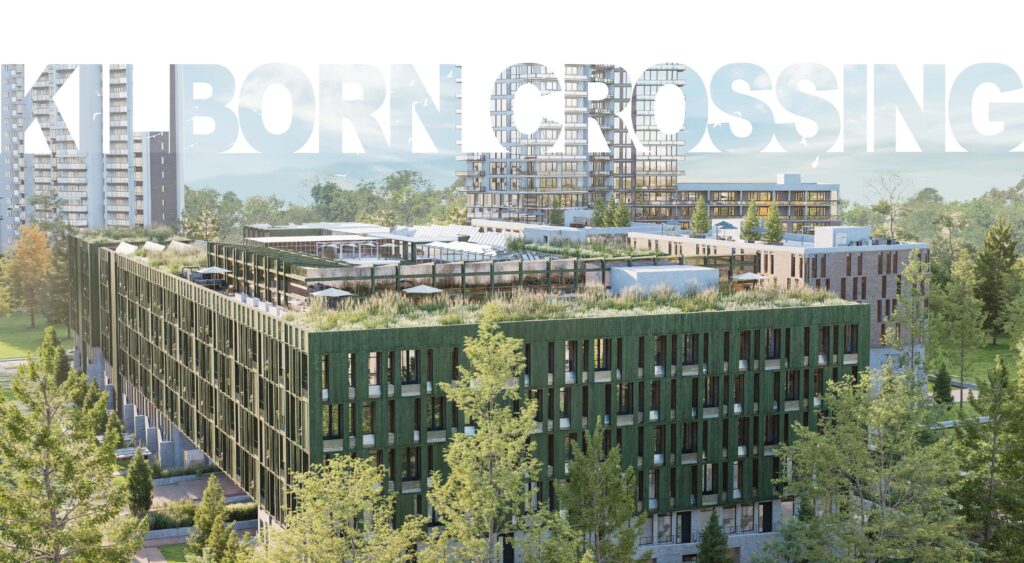
The project focuses on creating dense, meaningful in-between spaces by interacting with the buildings on the site and the sprawling paths. The buildings are designed to support a wide demographic of people and lifestyles with below-market, student, family, and permanent supportive units. The design offers accessibility to all locations while maximizing microclimate environments and landscaped areas. The high-rise development focused on building density while maintaining active green space. This allowed us to blend affordable and market housing, aiming to use the market units to subsidize the cost of construction for permanent supportive housing.
Jury Comments: There is a strong emphasis on good quality elevations, a strong focus on the public ground, the greenery weaving in and around those buildings, and an exceptional quality of renderings. We appreciated the strong video. It’s amazing how much digital representation transforms your perception of a project.
Top Prize: $1,000
Alta Vista Oasis (Kilborn Place)
Will Girard and Marandy Gonzalez
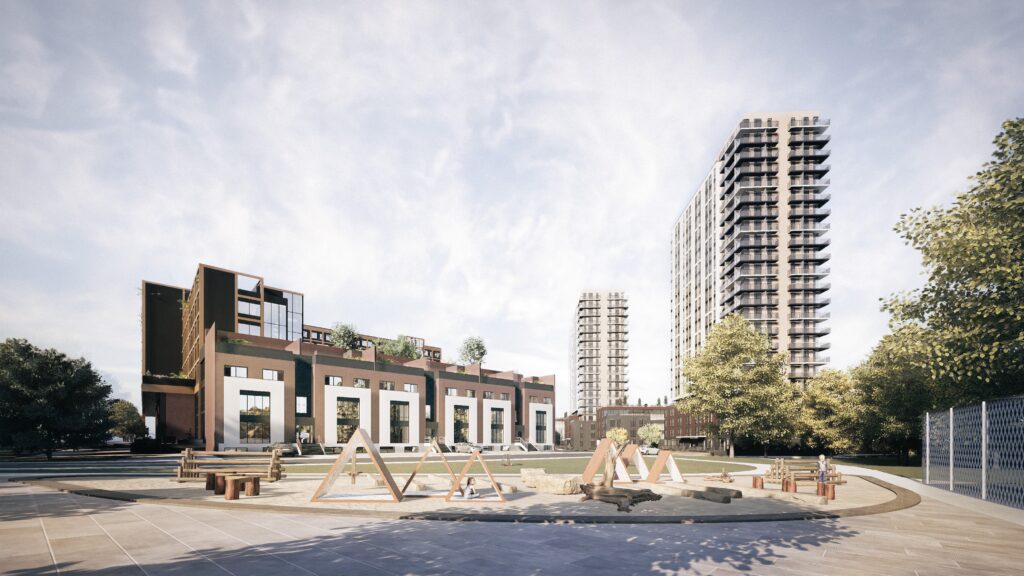

The Alta Vista Oasis introduces height and density within a suburban fabric. The building heights step down from a 23-storey and 19-storey rental tower (The Pair) to 10-storey affordable and permanent supportive housing (The Lodge), which dissolves into stacked townhomes. Communal spaces at multiple elevations offer varying activity levels and make use of the abundant underused green space and old-growth foliage. The Lodge funnels pedestrians through a cantilevered corner opening toward public amenities in the central courtyard. Using mass timber for rapid implementation, the Alta Vista Oasis aims to foster social interaction and belonging for residents.
Jury Comments: The jury appreciated the exceptional quality public realm, the master plan, the building elevations, the idea of using prefabricated architecture, and the materiality of the buildings. The stepping from your mid-rise typologies down to the low-rise typologies was interesting. The road infrastructure was successful in bringing people to the site.
Top Prize: $1,000
Pinecrest Pavilion (Foster Farm)
Darion Dillabaugh and Lauren Newell
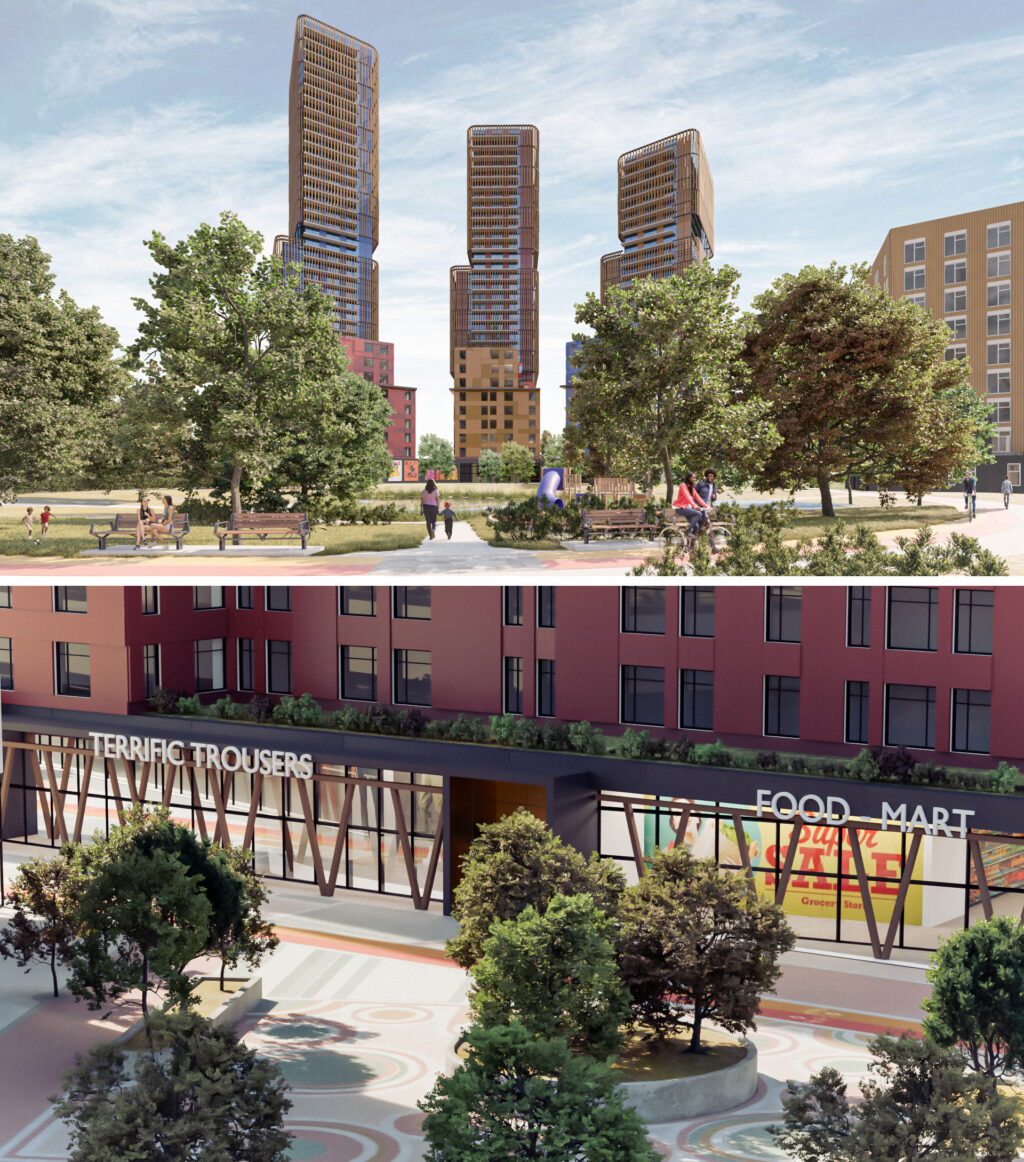
Pinecrest Pavilion envisions transforming this 9.1-hectare site, adjacent to the new Pinecrest LRT station, by adding 3,000 new residential units while preserving the existing 210-unit apartment tower. The project introduces a mix of residential, commercial, and community spaces. The site is structured around a central circular plaza, with density decreasing outward in a radial pattern. This arrangement promotes a vibrant, community-focused core while transitioning to quieter, more private areas at the periphery. Vehicle access is limited to the site’s edges and underground parking, ensuring a pedestrian-friendly environment. The design prioritizes light and shadow management, with decreasing building heights toward the west to maximize sunlight exposure.
Jury Comments: Beautiful radial plan in the master plan, arrangement of towers in the right locations, complemented with mid-rise forms, and then down to public realm spaces. The jury appreciated the textures of the public realm spaces and the rigor that went into defining those pedestrian spines through the project.
Honourable Mention: $500
Pocket Hub (Greenboro)
Helen Wang and Yiping Zhan
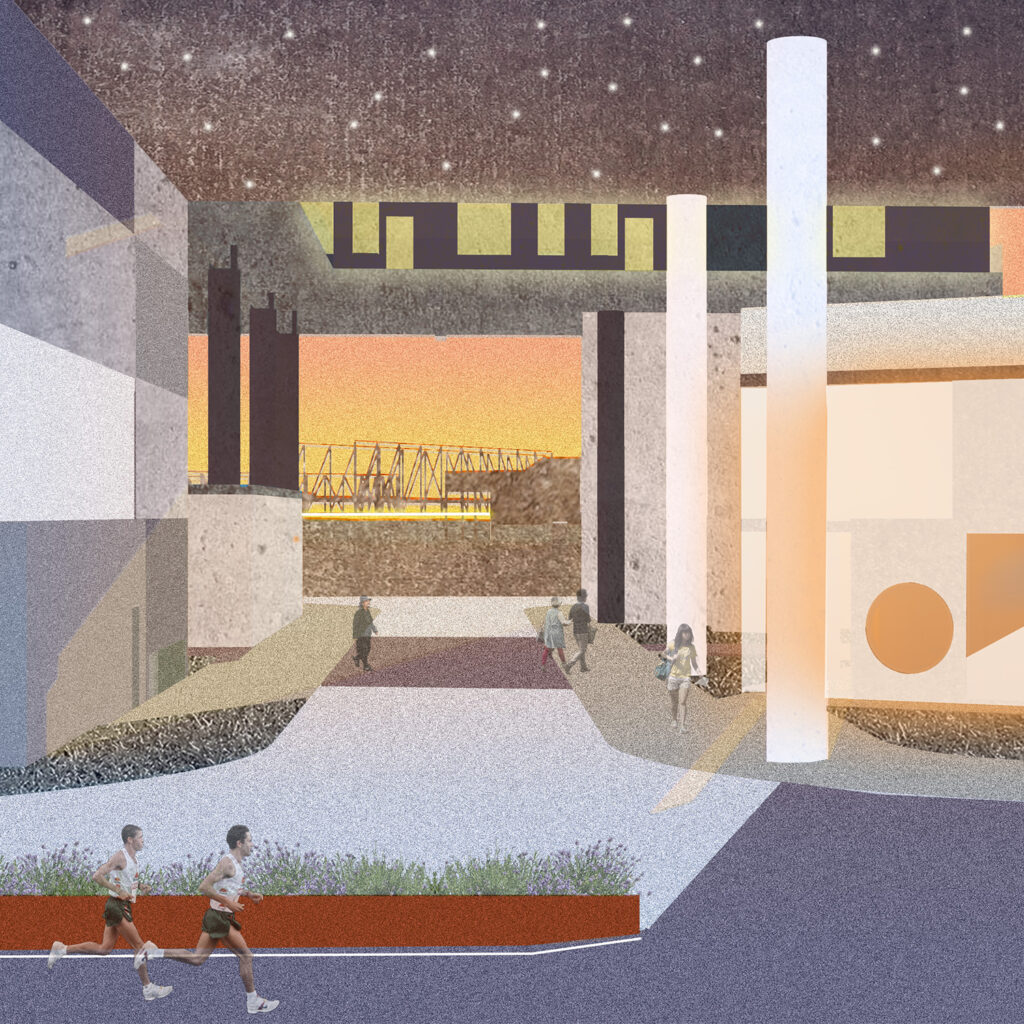
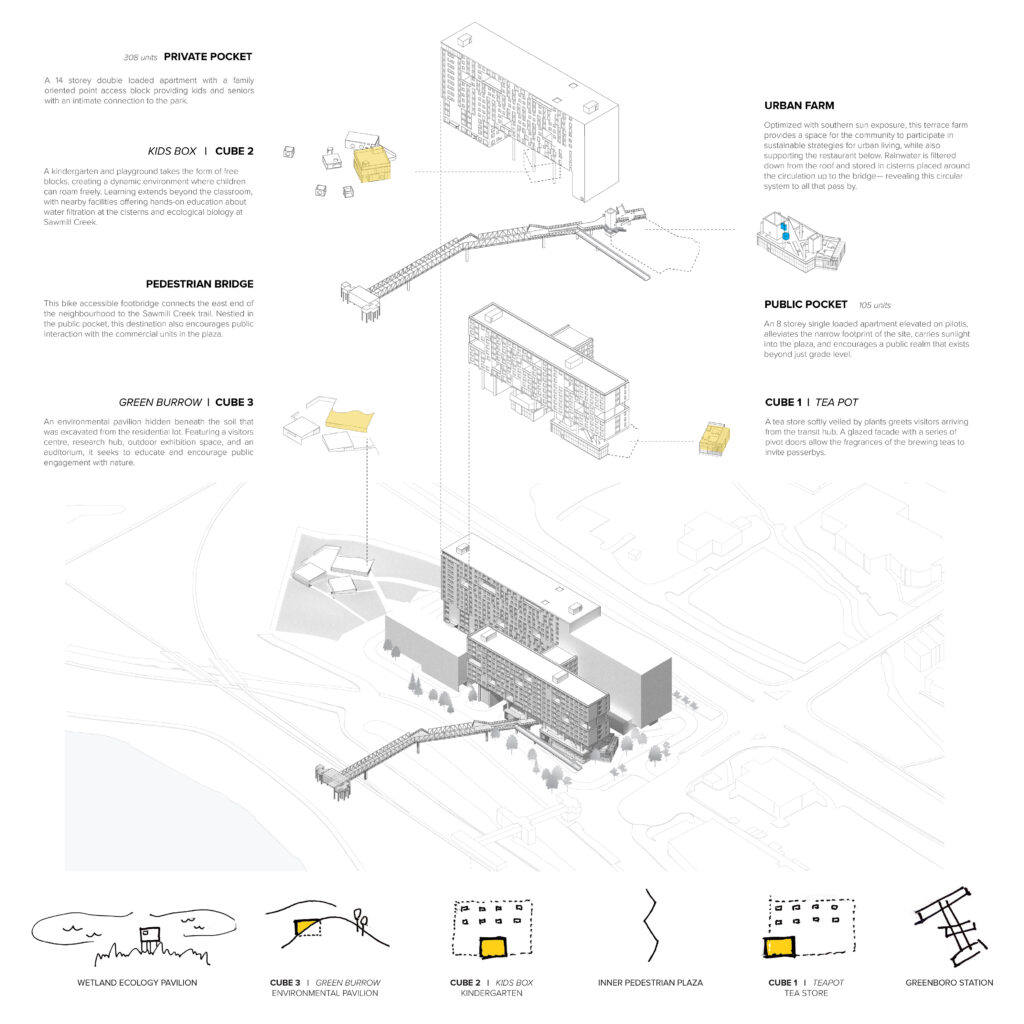
Pocket Hubs envisions the Greenboro Station parking lot as a playful destination for students, young families, and seniors to live and grow in an urban setting. Organized around three key zones, each features a space curated to foster a sense of identity for the development. The Tea Pot, Kids Box, and Green Burrow are designed to invite interaction, establishing the site as a destination hub for OC Transpo users and the surrounding community. Elevated residential spaces with voids below and between the building blocks, allow community spaces to be celebrated at all levels of the project.
Jury Comments: Two very strong forms arranged on the public landscape provide a lot of great animation and break down the scale. Although these two buildings are quite tall, they provide porosity and scale-oriented programs. These little cubes at grade create a human scale and a sense of vibrancy. Some amenities transitioning throughout the seasons was a nice gesture.
–
Honourable Mention: $500
Greenline Court (Greenboro)
Megan Elekes and Kayla Wallace
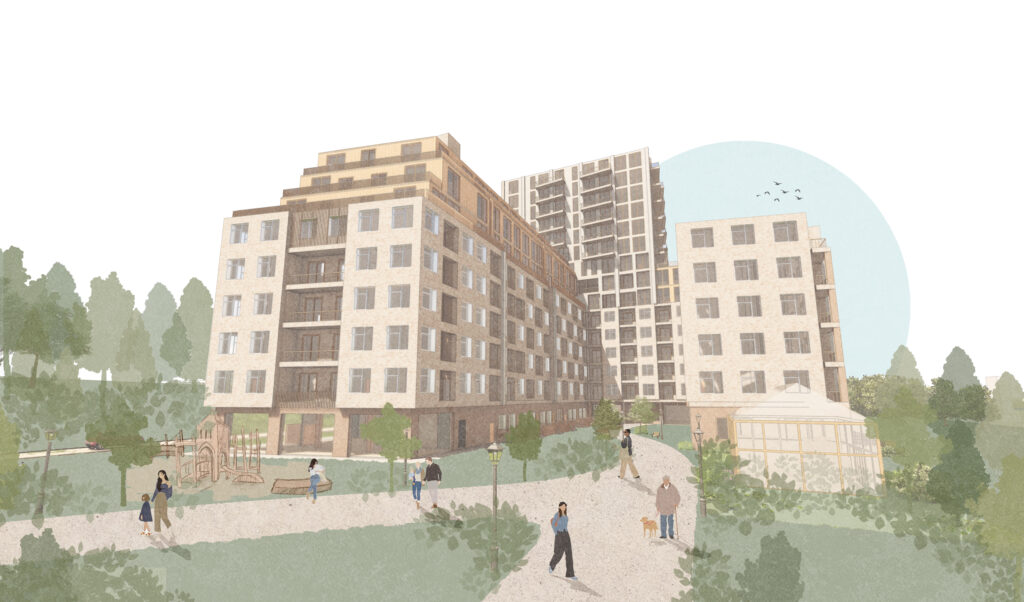
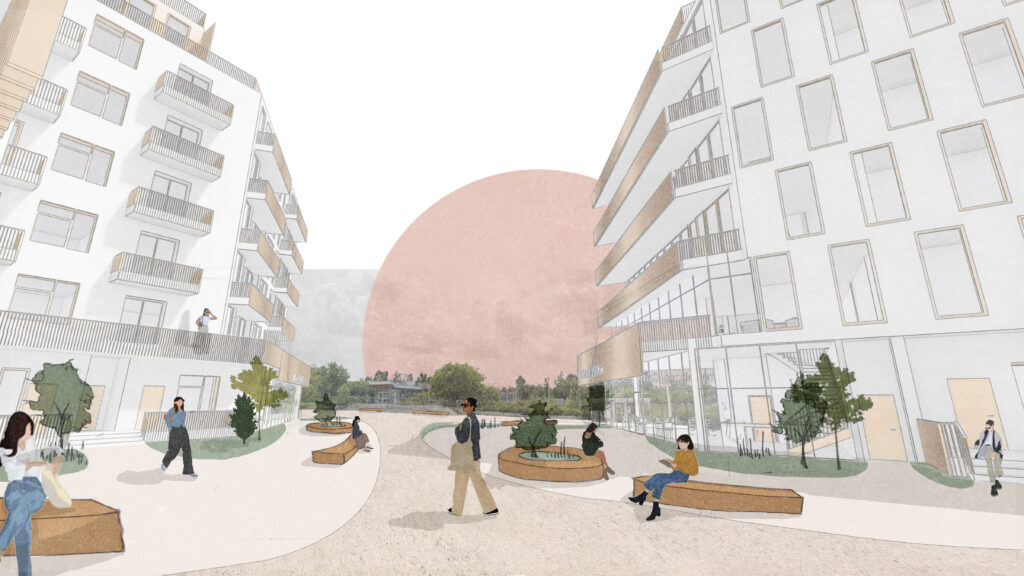
Two sister buildings offer about 600 residential units. Cedar Glade on the northern edge blends with Greenboro’s natural surroundings, bridging urban and natural spaces with greenery, while Aspen Grove on the southern end, connected to Greenboro Station, serves as a gateway, fostering community interaction and integrating urban life with transit. The design integrates commercial spaces, essential services, and outdoor areas. By blending public and private residential zones, we aim to foster a sense of inclusivity, while pedestrian-friendly pathways and sustainable practices enhance the environmental and social fabric of the development.
Jury Comments: This was an interesting approach. The assemblage of the buildings on site, specifically how the first building interacts with the LRT and creates a welcoming plaza drawing you into the site, and then the second building which interacts with the park on the north side.
Honourable Mention: $500
Cobblestone Commons (Foster Farm)
Klariza Mae Juntilla and Sharmeen Rizvi
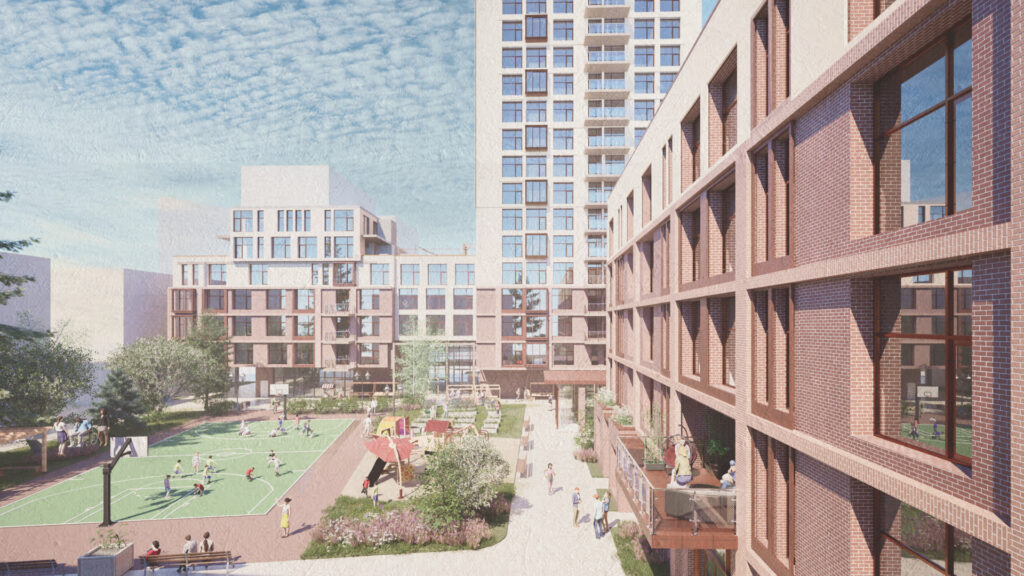
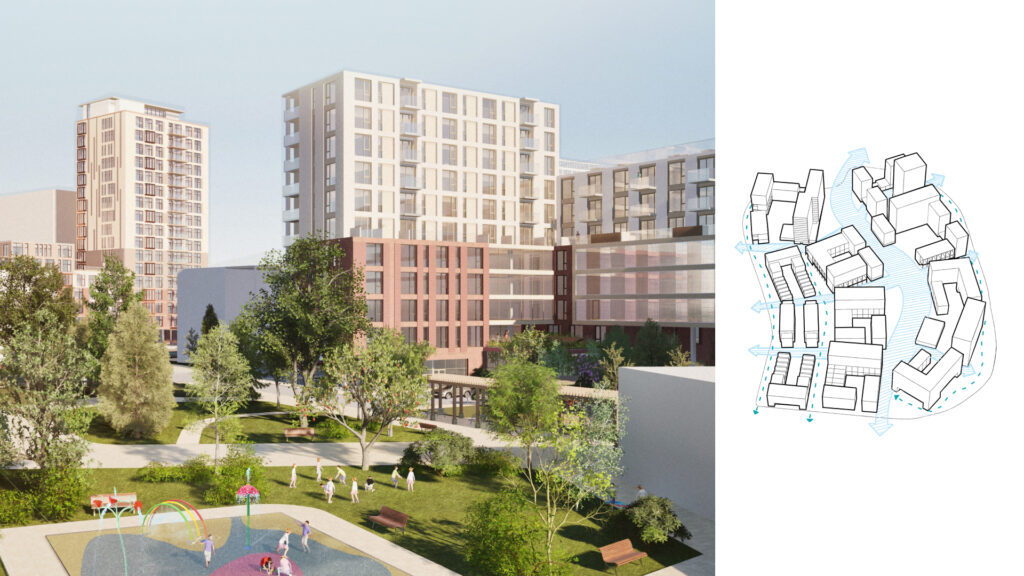
This project transforms the site into a vibrant, pedestrian-oriented hub, where pathways connect residents to essential services and community spaces, including a farm-to-table market and an urban garden. A thoughtfully planned public square, seasonal ice rink, and sledding hill create spaces for year-round interaction. The development integrates mixed-income housing, with affordable and market units distributed across the site, fostering inclusivity. Green spaces, stormwater management features, and urban agriculture enhance both environmental resilience and quality of life.
Jury Comments: Some strong rendering visuals connecting the buildings and the public realm at grade showing good quality residential private and public spaces knitting together. The idea of thinking about the seasons, engaging those spaces, and understanding how they change with each season is extremely important. In our climate, we can harness outdoor experiences and try to capitalize on them.
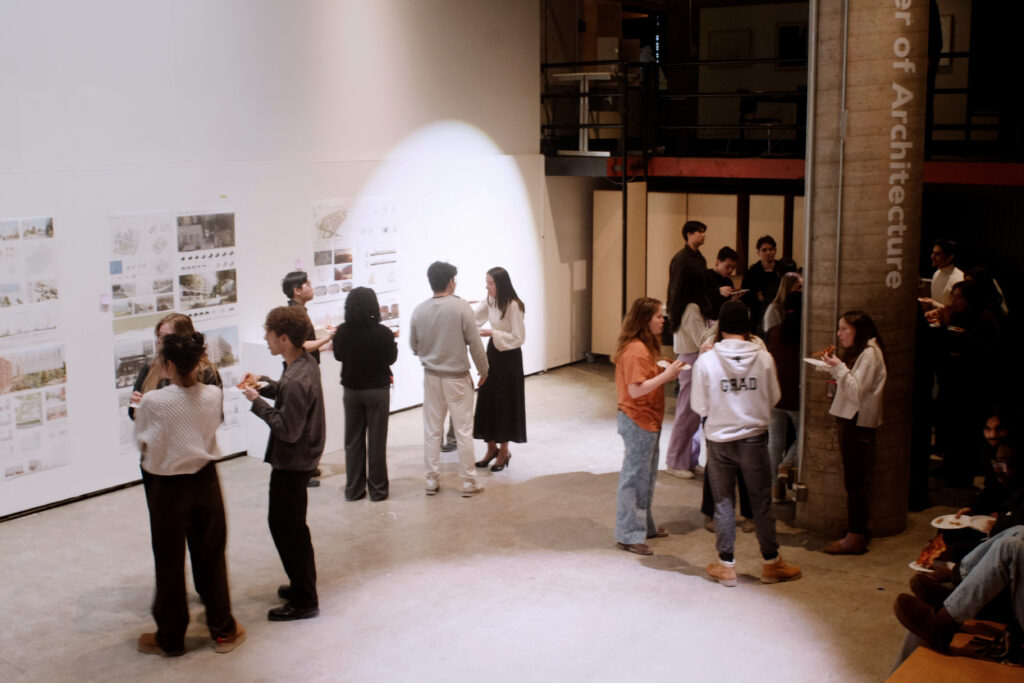
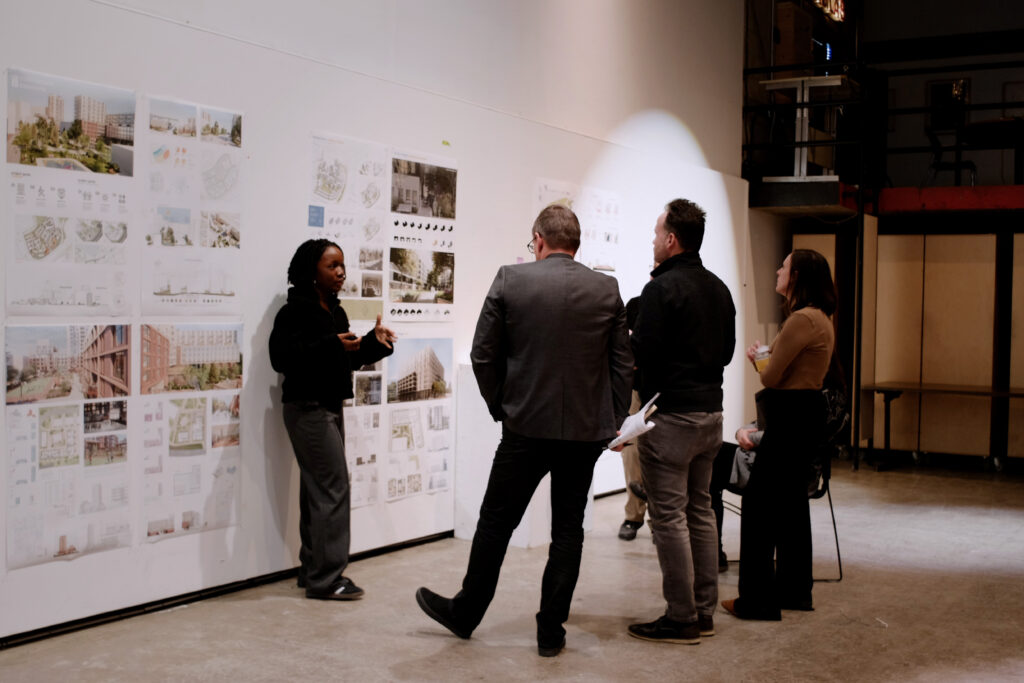
About the fourth-year housing studio
The comprehensive studio, organized by Associate Professor Benjamin Gianni, asks students to consider multiple-unit residential buildings, which provide high-density housing.
The sites chosen each year typically are large tracts of land slated for imminent redevelopment by private or public organizations.
Students must consider the project at several scales. First, working in pairs, they make an urban design proposal providing new streets, landscapes, public spaces, building sites, and massing.
Next, students choose a building or group within the overall layout to design. The construction details demonstrate structure, materials, and assemblies, and address climate, trades, and sustainability.
The site owners, which can include the City of Ottawa, developers, and non-profit agencies are typically involved in the studio. They help identify objectives, market and social considerations, and affordability, and attend reviews of student work.
The three sites for the fall 2024 studio were:
Site One – Kilborn Place
The former Diocesan Centre at 1245-1247 Kilborn Place sits on 8.7 acres of land that the City of Ottawa hopes to develop. The city considers it suitable for 500-to-800 new housing units with a mix of market and affordable rents, plus 50 supportive units and a major community park. The site is within walking distance of the Billings Bridge shopping centre. The adaptive reuse or demolition of an existing building is a question. Students worked with the City of Ottawa, including planners and housing developers.
Site Two – Greenboro LRT Park & Ride site
The site is owned by the City of Ottawa and has been a parking & ride lot for the Greenboro LRT station, which was the last stop on the Trillium Line. Now that the line has been extended, it is unclear what the demand for parking might be. It is assumed the site would be targeted for social housing with some component of market housing. The site is adjacent to the South Keys shopping plaza. Being close to the airport, towers are limited to 21 storeys. Students worked with a community group called Better South Keys.
Site Three – Foster Farm
Ottawa Community Housing, which operates housing on the 22-acre site in west-end Ottawa, is planning for redevelopment. There are 430 existing units, while the target for redevelopment is 4,000 units. The neighbourhood is bounded on the south by Highway 417 and adjacent to the new Pinecrest Phase 2 LRT station. The City of Ottawa has approved towers up to 40 storeys. With more people in the area, the development must include commercial uses such as grocery stores. Students worked with representatives of Ottawa Community Housing.